|
San Diego City and County Historic Designations
By Ann Jarmusch
March/April 2023
At its January 2023 meeting, the City of San Diego Historical Resources Board entered what may be a challenging new era in California historic preservation. Members considered for the first time the designation of a 1931 house with a newly completed Accessory Dwelling Unit on the property. The two-story ADU loomed large in their thinking, as it did in real life, where the shed roof slopes up to 12 feet. Their general concern was that new ADUs, which state law now encourages over preservation and other factors to help meet the affordable housing shortage, will overwhelm historic homes. Ultimately, they designated the Spanish Colonial Revival house at 4190 Utah Street in North Park, which is described below. To hear this discussion of Item 6, watch on YouTube at time mark 51:57.
HRB staff announced that preservation mitigation measures that the board created and recommended to the City’s Planning Commission for site development permits were approved along with the projects. One is the 1915 Botanical Building in Balboa Park; extensive restoration is expected to be completed in Spring 2024. The City Council approved the Mira Mesa Community Plan Update, including the historic components section the HRB approved.
The Bungalow Court and Apartment Court Historic Context Statement, already approved by the California Office of Historic Preservation that funded it, is posted with a cover memo from Kelley Stanco, who oversees the historic preservation staff and Development Services. Given the OHP's approval, the document is legally in effect.
In 2022, the 50th anniversary year of the California Mills Act preservation incentive, the City received 145 Mills Act contract requests and processed 140 of them. March 31, 2023 is this year’s deadline to apply for a contract on a historic resource designated as of December 31, 2022. Applicants may use a new online portal. Learn more about the way the City administers the Mills Act.
In all, the HRB designated six historic buildings in January, five houses and one commercial building.
|
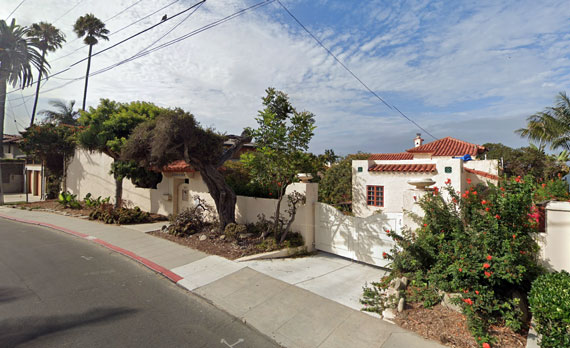 6110 Camino de la Costa, is the 1924 Herbert York/Herbert Palmer House, designated on all four HRB criteria. This rare distinction starts with Criterion A: The Spanish Colonial Revival style home is regarded as a special element of the community’s development. Hugging a blufftop, it is the oldest intact residence in La Jolla Hermosa, the first subdivision within the La Jolla community. It is also the only known structure designed by Master Architect Herbert Palmer in this neighborhood of architect-designed homes. Herbert York is the distinguished resident, fulfilling Criterion B. York was a nuclear physicist who worked on the Manhattan Project, the director of research and engineering for the U.S. Defense Department, and the first chancellor of the University of California, San Diego. He worked nationally and internationally on arms control and other deterrents to nuclear war. York and his wife, Sybil, bought the house after he resigned the chancellorship. He remained a UCSD physics professor and later served as vice chancellor and then chancellor for a second time. York also founded the university’s Institute on Global Conflict and Cooperation. The house itself, being a good example of the Spanish Colonial Revival style, meets Criterion C. The two-story home facing the ocean embodies elements of the style: a courtyard with an original fish pond; main arched wooden entry door; a two-story tower with hipped roof; red-clay tiled roofs; an ocean-view balcony covered with a shed roof that extends the length of the house; wood-framed windows in a variety of sizes and types of operation, including arched windows on the ocean facade; and a stucco exterior. As a notable work of Master Architect Palmer, the home qualifies on Criterion D. He designed several houses in La Jolla and at least six of his custom designs have been added to San Diego’s historic register. Photo courtesy Google Street View 6110 Camino de la Costa, is the 1924 Herbert York/Herbert Palmer House, designated on all four HRB criteria. This rare distinction starts with Criterion A: The Spanish Colonial Revival style home is regarded as a special element of the community’s development. Hugging a blufftop, it is the oldest intact residence in La Jolla Hermosa, the first subdivision within the La Jolla community. It is also the only known structure designed by Master Architect Herbert Palmer in this neighborhood of architect-designed homes. Herbert York is the distinguished resident, fulfilling Criterion B. York was a nuclear physicist who worked on the Manhattan Project, the director of research and engineering for the U.S. Defense Department, and the first chancellor of the University of California, San Diego. He worked nationally and internationally on arms control and other deterrents to nuclear war. York and his wife, Sybil, bought the house after he resigned the chancellorship. He remained a UCSD physics professor and later served as vice chancellor and then chancellor for a second time. York also founded the university’s Institute on Global Conflict and Cooperation. The house itself, being a good example of the Spanish Colonial Revival style, meets Criterion C. The two-story home facing the ocean embodies elements of the style: a courtyard with an original fish pond; main arched wooden entry door; a two-story tower with hipped roof; red-clay tiled roofs; an ocean-view balcony covered with a shed roof that extends the length of the house; wood-framed windows in a variety of sizes and types of operation, including arched windows on the ocean facade; and a stucco exterior. As a notable work of Master Architect Palmer, the home qualifies on Criterion D. He designed several houses in La Jolla and at least six of his custom designs have been added to San Diego’s historic register. Photo courtesy Google Street View
|
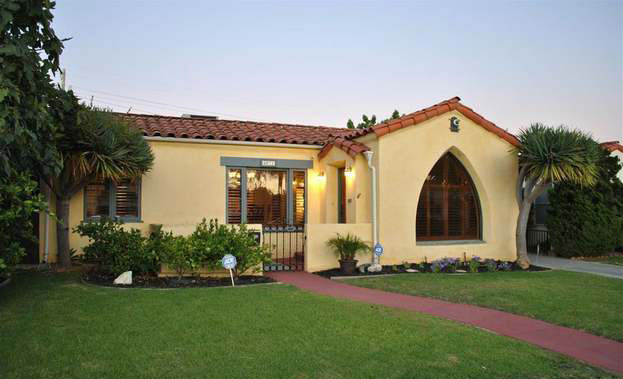 4971 Kensington Drive in the Kensington-Talmadge Community, is a 1929 Spanish Colonial Revival home built as the Carl and Ethel Mae Sharp Spec House #1. It meets HRB Criterion C with its retention of original architectural elements such as an asymmetrical facade, wood front door, arched focal window, a cross gabled roof with red tiles and little eave overhang, stucco exterior, tapered stucco chimney, wood lintels, and multi-light and single-light wood-framed windows. The designation excludes the 2010 rear bedroom addition. (The Sharps’ own home, built in 1937 at 3425 Xenophon Street, was designated at this same meeting.) Photo courtesy redfin.com 4971 Kensington Drive in the Kensington-Talmadge Community, is a 1929 Spanish Colonial Revival home built as the Carl and Ethel Mae Sharp Spec House #1. It meets HRB Criterion C with its retention of original architectural elements such as an asymmetrical facade, wood front door, arched focal window, a cross gabled roof with red tiles and little eave overhang, stucco exterior, tapered stucco chimney, wood lintels, and multi-light and single-light wood-framed windows. The designation excludes the 2010 rear bedroom addition. (The Sharps’ own home, built in 1937 at 3425 Xenophon Street, was designated at this same meeting.) Photo courtesy redfin.com
|
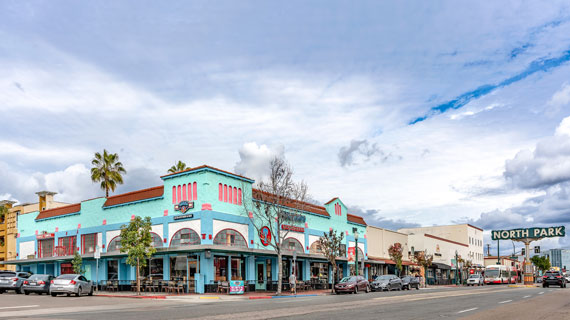 2906-2912 University Avenue in North Park is the Edward and Emma Newman Building with a period of significance of 1929-1932, the years the building housed Mudd Department Store, North Park’s first department store. As an important part of the community’s development, it was designated on HRB Criterion A. Its architecture fulfills Criterion C by embodying the characteristics of the One-Part Commercial Block style in 1929. Built in a block form and filling the entire parcel, the structure also retains large glass display windows for commercial use; and a large, wide wall above the storefront intended for signage. In addition, the building continues to convey the Spanish Colonial Revival style with its faux-adobe stucco exterior, pilasters with scroll-like capitals, corner tower, arched transom windows, terra cotta tile accents, and clay pipe attic vents. Photo courtesy loopnet.com 2906-2912 University Avenue in North Park is the Edward and Emma Newman Building with a period of significance of 1929-1932, the years the building housed Mudd Department Store, North Park’s first department store. As an important part of the community’s development, it was designated on HRB Criterion A. Its architecture fulfills Criterion C by embodying the characteristics of the One-Part Commercial Block style in 1929. Built in a block form and filling the entire parcel, the structure also retains large glass display windows for commercial use; and a large, wide wall above the storefront intended for signage. In addition, the building continues to convey the Spanish Colonial Revival style with its faux-adobe stucco exterior, pilasters with scroll-like capitals, corner tower, arched transom windows, terra cotta tile accents, and clay pipe attic vents. Photo courtesy loopnet.com
|
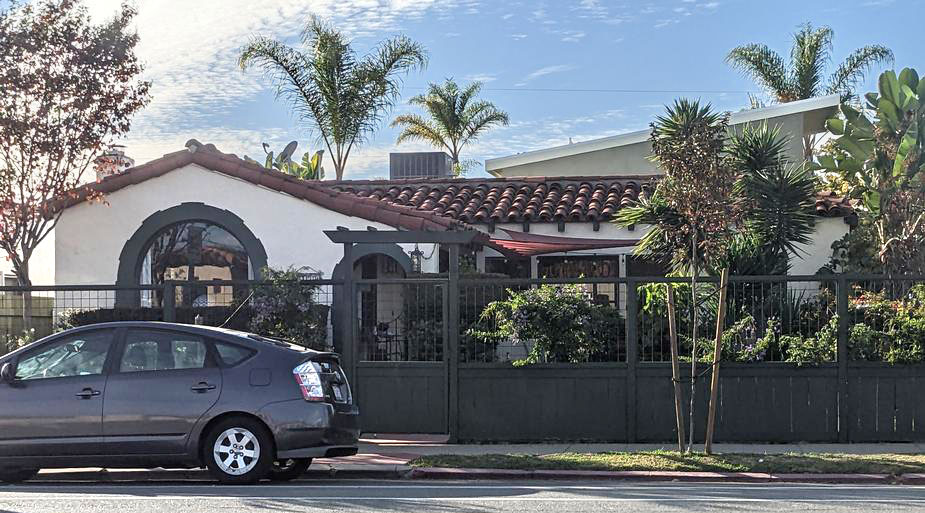 4190 Utah Street in North Park is a Spanish Colonial Revival style home built in 1931. The Michael and Helen Donnelly House was designated under HRB Criterion C for retaining character-defining features of the style. Among these are a moderately pitched roof topped with red terra-cotta tiles, smooth stucco exterior, detailed wooden entry door, stylized arched windows and doors, asymmetrical facade, limited eave overhanging with exposed rafter tails, stucco chimney, and wood-framed windows. The designation excludes the 2022 Accessory Dwelling Unit with a 12-foot-tall shed roof that is visible in the photo. As the first historic home with an ADU on the same property to be considered by the HRB, this nomination prompted thoughtful discussion among members and staff. The ADA was designed and built after the owner applied for historic status for their 1931 home. 4190 Utah Street in North Park is a Spanish Colonial Revival style home built in 1931. The Michael and Helen Donnelly House was designated under HRB Criterion C for retaining character-defining features of the style. Among these are a moderately pitched roof topped with red terra-cotta tiles, smooth stucco exterior, detailed wooden entry door, stylized arched windows and doors, asymmetrical facade, limited eave overhanging with exposed rafter tails, stucco chimney, and wood-framed windows. The designation excludes the 2022 Accessory Dwelling Unit with a 12-foot-tall shed roof that is visible in the photo. As the first historic home with an ADU on the same property to be considered by the HRB, this nomination prompted thoughtful discussion among members and staff. The ADA was designed and built after the owner applied for historic status for their 1931 home.
|
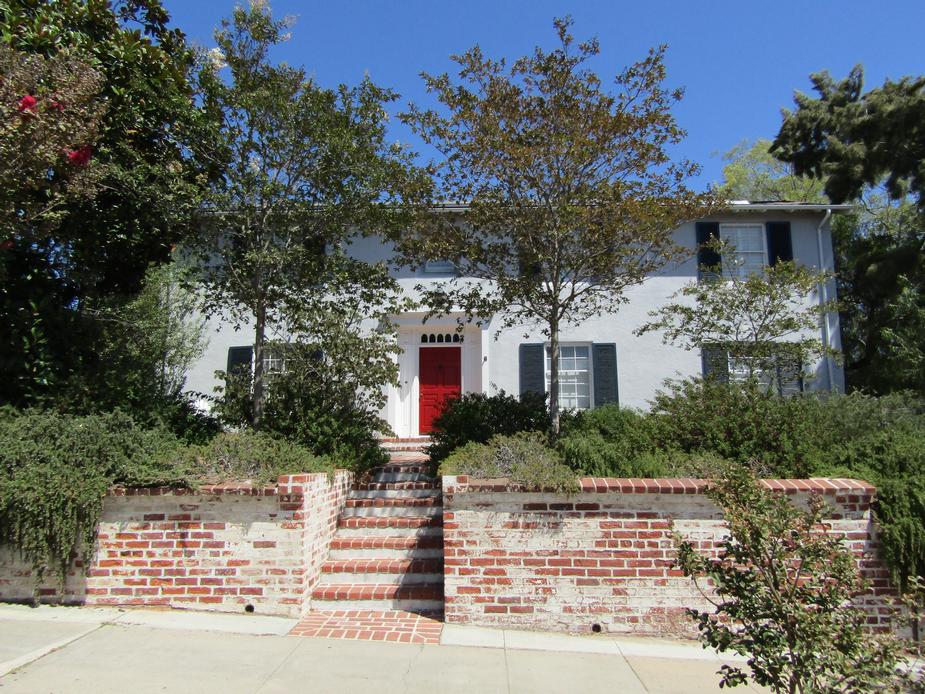 4603 56th Street in the College Area is the Erby and Mabel Deputy House, built in the Colonial Revival style in 1936. Recognized for HRB Criterion C, the house has an accentuated front entry with a Georgian-style entablature and pilasters, paneled front door, a single-line of transom lights over the door, cross gabled roof form, bay windows with classical cornice molding, and double hung windows with wood shutters. A breezeway with an original wooden gate connects the residence with the stucco garage, built with a hipped roof and an original birdhouse cupola. The designation includes the 1936 garage, brick site wall, and brick barbeque. 4603 56th Street in the College Area is the Erby and Mabel Deputy House, built in the Colonial Revival style in 1936. Recognized for HRB Criterion C, the house has an accentuated front entry with a Georgian-style entablature and pilasters, paneled front door, a single-line of transom lights over the door, cross gabled roof form, bay windows with classical cornice molding, and double hung windows with wood shutters. A breezeway with an original wooden gate connects the residence with the stucco garage, built with a hipped roof and an original birdhouse cupola. The designation includes the 1936 garage, brick site wall, and brick barbeque.
|
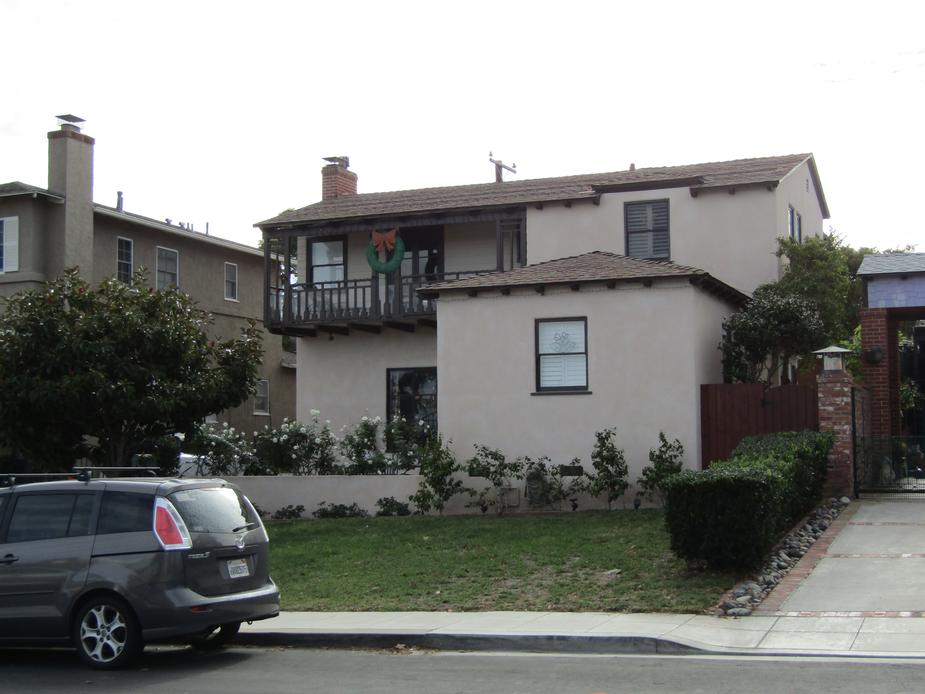 3425 Xenophon Street in the Peninsula Community is a two-story home built in 1937 in the Spanish Colonial Revival style with a Monterey style cantilevered second-floor balcony covered by the primary roof. The Carl and Ethel Mae Sharp House meets HRB Criterion C for retaining key elements of these two architectural styles. These include a low-pitched, combined hipped-and-gabled roof with minimal eave overhang; smooth stucco and wood cladding; brick chimney; asymmetrical primary facade; multi-light and single-light wood-framed windows; and French doors. The designation excludes the 1967 and 2019 rear additions. 3425 Xenophon Street in the Peninsula Community is a two-story home built in 1937 in the Spanish Colonial Revival style with a Monterey style cantilevered second-floor balcony covered by the primary roof. The Carl and Ethel Mae Sharp House meets HRB Criterion C for retaining key elements of these two architectural styles. These include a low-pitched, combined hipped-and-gabled roof with minimal eave overhang; smooth stucco and wood cladding; brick chimney; asymmetrical primary facade; multi-light and single-light wood-framed windows; and French doors. The designation excludes the 1967 and 2019 rear additions.
|
At the HRB’s February 2023 meeting, members discussed the staff-produced Certified Local Government Annual Report 2021-2022, which is required by the California Office of Historic Preservation and the Municipal Code for the fiscal year. Among the HRB’s accomplishments: designated 35 significant properties; successfully nominated the Inspiration Heights Historic District to the National Register of Historic Places, including 62 new historic landmarks; and processed 62 Mills Act contracts. You can read the entire report.
Board members named two concerns for staff to pass along with the report to Mayor Todd Gloria and the City Council. They requested help and perhaps more funding for code enforcement, as they witness unpermitted alterations, such as new windows, being installed and damaging San Diego’s potential future historic resources. And they wanted to remind the Mayor that HRB is still short of the required number of members and requested that he nominate new ones. They have 10 out of 11 members now.
Staff announced that a designation appeal will be considered by the City Council on March 6, 2023. Being appealed is HRB #1412, the Charles and Mary Schaeffer Residence, 820 W. University Avenue, and the Fred Bushman Building, 3951-3957 Goldfinch Street. And the City recently hired a new planner with experience in historic resources.
The HRB also designated two houses that meet HRB Criterion C, which recognizes distinctive characteristics of an architectural style. |
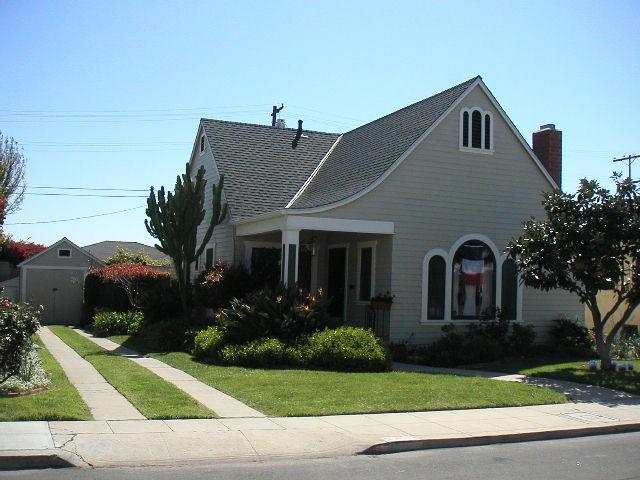 3461 Olive Street in North Park is a Tudor Revival style house built in 1928 by Harrison and Salvadora Kellenberger as their residence. This single-story dwelling features a steeply pitched, cross gabled roof that dominates the primary facade. This primary elevation is asymmetrical with an inset front porch entry and includes a dominant front facing gable with an arched tripartite focal window on the first floor and an arched attic vent that mimics the window design in the gable end. The exterior has original redwood clapboard siding, a large brick chimney, and multi-light wood-framed windows. A Hollywood style driveway (or ribbon style, with two concrete tracks for the tires) runs just east of the house. The garage is original except for the door, which has been replaced with a compatible design. The designation excludes the two rear additions. 3461 Olive Street in North Park is a Tudor Revival style house built in 1928 by Harrison and Salvadora Kellenberger as their residence. This single-story dwelling features a steeply pitched, cross gabled roof that dominates the primary facade. This primary elevation is asymmetrical with an inset front porch entry and includes a dominant front facing gable with an arched tripartite focal window on the first floor and an arched attic vent that mimics the window design in the gable end. The exterior has original redwood clapboard siding, a large brick chimney, and multi-light wood-framed windows. A Hollywood style driveway (or ribbon style, with two concrete tracks for the tires) runs just east of the house. The garage is original except for the door, which has been replaced with a compatible design. The designation excludes the two rear additions.
|
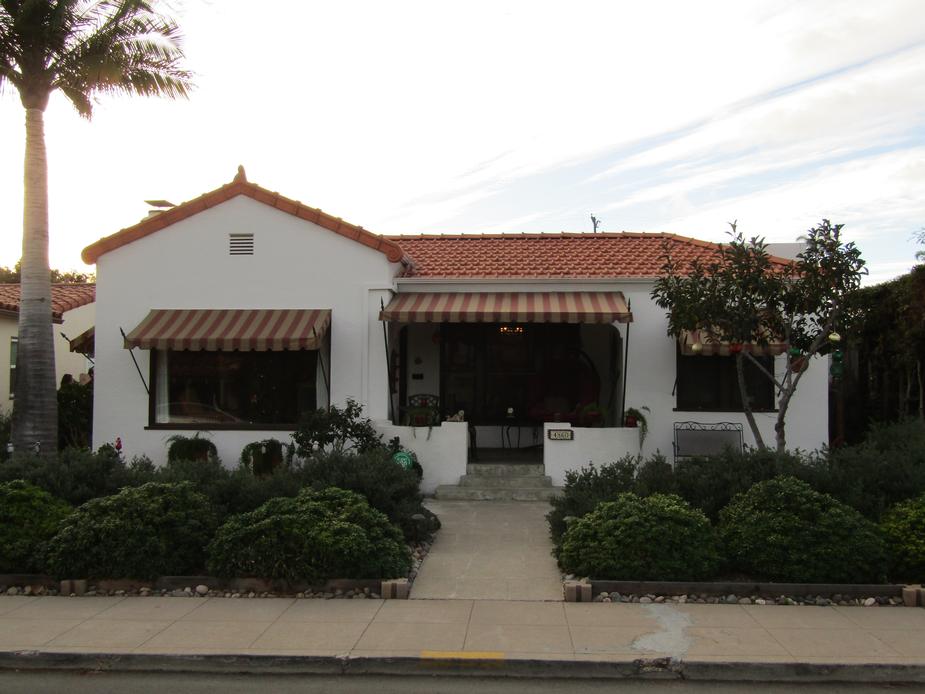 4860 Biona Drive in the Kensington-Talmadge Community is a 1929 Spanish Colonial Revival style home. The Charles and Alma Bickel House embodies characteristics of the style with a centered, recessed entry porch with low stucco walls; asymmetrical primary facade; a predominately flat roof with a parapet; tiled cross gable roof at the front with an ornamental finial; stucco exterior and chimney; iron window grilles; and multi-light and single-light wood-framed windows. The HRB added the name of Alma Bickel, Charles’ spouse, to the historic resource. 4860 Biona Drive in the Kensington-Talmadge Community is a 1929 Spanish Colonial Revival style home. The Charles and Alma Bickel House embodies characteristics of the style with a centered, recessed entry porch with low stucco walls; asymmetrical primary facade; a predominately flat roof with a parapet; tiled cross gable roof at the front with an ornamental finial; stucco exterior and chimney; iron window grilles; and multi-light and single-light wood-framed windows. The HRB added the name of Alma Bickel, Charles’ spouse, to the historic resource.
|
City of Coronado Designation Overturned
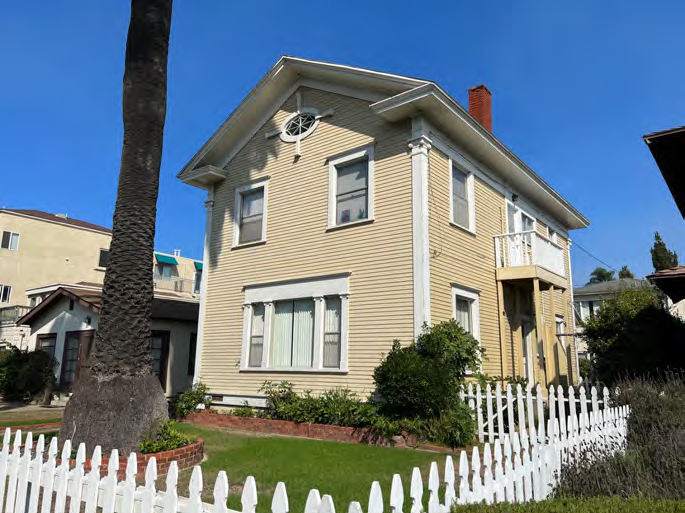 In January 2023, the 2022 designation of an 1896 Colonial Revival style house at 741-745 Orange Avenue was appealed to the City Council and the appeal was upheld. This beautiful home was overturned with a vote of 3 to 2 by request of the property owner. The home is one of the most prominent along Orange Avenue. SOHO spoke against the removal of the designation and we maintain they did not have the grounds to overturn it. Photo courtesy City of Coronado In January 2023, the 2022 designation of an 1896 Colonial Revival style house at 741-745 Orange Avenue was appealed to the City Council and the appeal was upheld. This beautiful home was overturned with a vote of 3 to 2 by request of the property owner. The home is one of the most prominent along Orange Avenue. SOHO spoke against the removal of the designation and we maintain they did not have the grounds to overturn it. Photo courtesy City of Coronado
|
All photos are from the California Historical Resources Inventory Database (CHRID), except where noted otherwise. The above designations were reviewed and approved by the City of San Diego Historical Resources Board (HRB), the County of San Diego Historic Site Board (HSB), or the Coronado Historic Resources Commission.
|
2025
2024
2023
2022
2021
2020
2019
2018
2017
2016
2015
|












